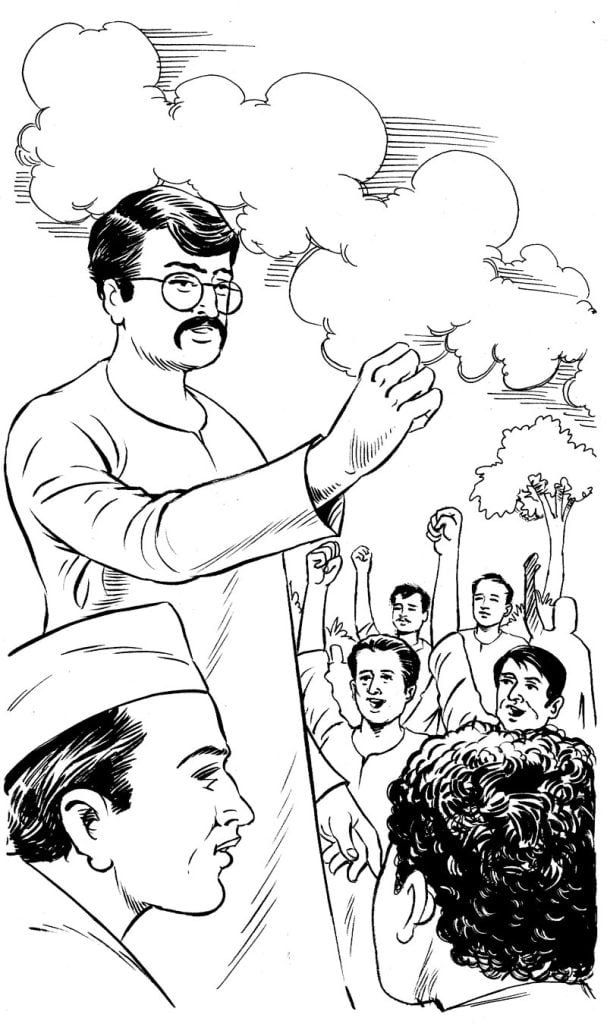Public speaking made Vidyarthi a respected and popular figure. As an editor he merely was an invisible phantom, a powerful mind. It had no face. But the public stage presented him to the people a figure with a charming face and sweet manners. Vidyarthi had a very pleasing personality which he was not conscious of.
His appearance on the stage used to be as graceful as the arrival of a prince in his court. His speeches were as clear and transparent as his thoughts. There was no ambiguity. Being a self made man he suffered no confusions like many others did. The others had degrees and academic diplomas but that in real sense meant the knowledge borrowed from the books which left wide gaps of confusions. Vidyarthi had earned the knowledge from the university of the practical life which was solid and free of confusions.

Now Vidyarthi’s daily schedule had become hectic as he had to attend meetings besides running Pratap.
He along with his friends was active in freedom politics also. They were the spirit behind the Kanpur chapter of the freedom struggle.
Meanwhile the country had come under the spell of Congress party. The countrymen had lined up behind Congress to fight for the independence from the colonial rule. But now the Congress had become a divided house due to the bickerings of its leaders. Two warring factions in the Congress had emerged that were inimical to each other. One was the soft liners and the other camp was of hard liners. The first group was for the party to maintain its soft line against the government. The hard liners were for the Congress to adopt confrontational line against the British.
But inspite of this freedom struggle did not lose its way. The rivalry proved only a short period setback.
And during this setback period revolutionary groups had made considerable progress. They had emerged as the heroes of the young people. The entire country was getting united against the common enemy, the British. Several leaders were involved in the social reforms and educational activities besides being engaged in the freedom politics of the mainstream. Social reforms and the spread of education were also the dimensions of the composite freedom movement because the evil customs and illiteracy were the causes of the perpetuation of the colonial rule.
In 1916, Lucknow Congress Session was held in which both the Congress groups took part. The people participated in large numbers.
Ganesh Shankara Vidyarthi thought that if Lokmanya Tilak and Gandhiji were brought to Kanpur from Lucknow it would spark off great awakening for the freedom struggle in Kanpur. This idea galvanised him to make it happen and he succeeded.
At the end of the Congress Session Vidyarthi brought the three pillars of Congress namely Tilak, Gandhi and Pollock to Kanpur. Tilak was put up in a Dharamshala near the railway junction. Vidyarthi brought Gandhi and Mr. Pollock to his Pratap office on a tonga. The leaders did not mind.
Gandhi and Pollack were beseated on a durrie spread on the Pratap office floor. The two leaders were symbols of the simple living and high thinking. They happily partook raw peanuts and Khichri without ghee offered by Vidyarthi. It was an unforgettable moment of Vidyarthi’s life.
Then, Vidyarthi brought in some prominent figures of Kanpur to interact with the great leaders. They included Dr. Murari Lal and Narain Prasad Nigam. Gandhi spoke to them and revealed the political agenda of Congress and advised them to exercise restraint and discipline.
Next day, procession of Lokmanya Tilak was taken out in the city with great enthusiasm and public participation. At the end Tilak delivered a long speech. It made desired impact on the people. They were charged up with the patriotic feelings and the desire to fight the alien rulers.
On that visit Gandhi was not accorded any public reception or he gave any speech. From Kanpur he left for Ahmedabad. Vidyarthi was able to get the benefit of Gandhi’s thoughts and his advice regarding the role of journalists and the students in the freedom struggle.
The visit of the top Congress leaders to Kanpur brought Kanpur in the political picture. After their visit flow of political leaders into Kanpur city began and it became one of the centres of the freedom movement. Thus, the credit of arousing the patriotic feelings of the people of Kanpur and bring the city into the freedom movement goes to Ganesh Shankara Vidyarthi who began this with his newspaper Pratap.
